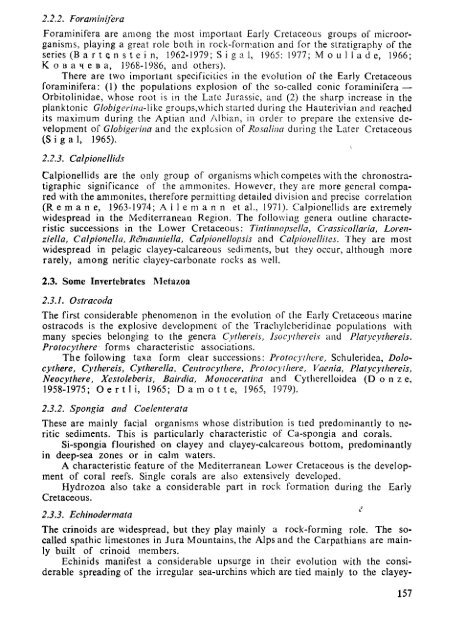THE MEDITERRANEAN LOWER CRETACEOUS
THE MEDITERRANEAN LOWER CRETACEOUS
THE MEDITERRANEAN LOWER CRETACEOUS
Create successful ePaper yourself
Turn your PDF publications into a flip-book with our unique Google optimized e-Paper software.
2.2.2. Foraminifera<br />
Foraminifera are among the most important Early Cretaceous groups of microorganisms,<br />
playing a great role both in rock-formation and for the stratigraphy of the<br />
series (Bartcnstein, 1962-1979; S i g a 1, 1965; 1977; M о u 1 1 a d e, 1966;<br />
К о в a ч e в a, 1968-1986, and others).<br />
There are two important specificities in the evolution of the Early Cretaceous<br />
foraminifera: (1) the populations explosion of the so-called conic foraminifera —<br />
Orbitolinidae, whose root is in the Late Jurassic, and (2) the sharp increase in the<br />
planktonic Globigerina-Wkz groups,which started during the Hauterivian and reached<br />
its maximum during the Aptian and Albian, in order to prepare the extensive development<br />
of Globigerina and the explosion of Rosalina during the Later Cretaceous<br />
(Si gal, 1965).<br />
2.2.3. Calpionellids<br />
Calpionellids are the only group of organisms which competes with the chronostratigraphic<br />
significance of the ammonites. However, they are more general compared<br />
with the ammonites, therefore permitting detailed division and precise correlation<br />
(R e m a n e, 1963-1974; A 1 1 e m a n n et al., 1971). Calpionellids are extremely<br />
widespread in the Mediterranean Region. The following genera outline characteristic<br />
successions in the Lower Cretaceous: Tintinnopsella, Crassicollaria, Lorenziella,<br />
Calpionella, Remanniella, Calpionellopsis and Calpionellites. They are most<br />
widespread in pelagic clayey-calcareous sediments, but they occur, although more<br />
rarely, among neritic clayey-carbonate rocks as well.<br />
2.3. Some Invertebrates Metazoa<br />
2.3.1. Ostraeoda<br />
The first considerable phenomenon in the evolution of the Early Cretaceous marine<br />
ostracods is the explosive development of the Trachyleberidinac populations with<br />
many species belonging to the genera Cythereis, Isocythereis and Platycythereis.<br />
Protocythere forms characteristic associations.<br />
The following taxa form clear successions: Protocythere, Schuleridea, Dolocythere,<br />
Cythereis, Cytherella, Centr осу there, Protocythere, Vaenia, Platycythereis,<br />
Neocythere, Xestoleberis, Bairdia, Monoceratina and Cytherelloidea (D о n z e,<br />
1958-1975; О e r 11 i, 1965; D a m о t t e, 1965, 1979).<br />
2.3.2. Spongia and Coelenterata<br />
These are mainly facial organisms whose distribution is tied predominantly to neritic<br />
sediments. This is particularly characteristic of Ca-spongia and corals.<br />
Si-spongia flourished on clayey and clayey-calcareous bottom, predominantly<br />
in deep-sea zones or in calm waters.<br />
A characteristic feature of the Mediterranean Lower Cretaceous is the development<br />
of coral reefs. Single corals are also extensively developed.<br />
Hydrozoa also take a considerable part in rock formation during the Early<br />
Cretaceous.<br />
2.3.3. Echinodermata<br />
The crinoids are widespread, but they play mainly a rock-forming role. The socalled<br />
spathic limestones in Jura Mountains, the Alps and the Carpathians are mainly<br />
built of crinoid members.<br />
Echinids manifest a considerable upsurge in their evolution with the considerable<br />
spreading of the irregular sea-urchins which are tied mainly to the clayey-<br />
157

















